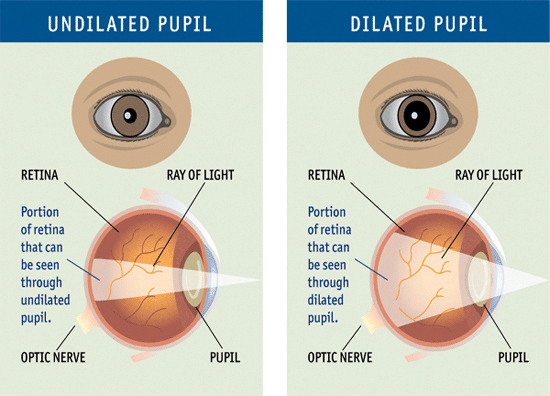Children's Examinations
Beginning at four years of age, amblyopia, refractive, and alignment screenings should take place. If you notice any signs of decreased vision or misalignment of the eye, please contact our office for a complete eye exam. A child exam is very similar to the care received in a regular routine exam.
These are the types of procedures that you can expect:

Autorefractor Testing
An autorefractor is sometimes used by doctors to determine a patient's prescription. A chin and forehead rest will help stabilize your child's head while he or she looks at a pinpoint of light—the hot air balloon. It is used to evaluate the way the retina focuses an image.
The Autorefractor Test is usually performed pre-exam by one of our trained Opticians.

Retinoscopy
A retinoscopy test will occasionally be peformed early in the eye exam so that the doctor can determine an approximate prescription. With the room's lights dim, your child will be asked to look through a machine and focus on a large target (usually the big "E" on the eye chart). The doctor will shine a light in his or her eye, while selecting different lenses. Based on how the light reflects on the retina, the refractive error will be calculated.
Autorefractive technology has allowed this reading to be obtained now by a computerized scan.

Refraction Assessment
The Refraction Assessment determines the eyeglass prescription. It helps the doctor determine the most accurate corrective lenses that will give you the best possible vision. Your child will be asked to look through a Phoroptor—a mask-like device that contains different lenses—which will help determine the best combination to give you the sharpest vision.
Which looks better...one...or two?

Visual Acuity Test
A Visual Acuity Test is a part of an eye exam performed to determine the smallest letters a patient can read on a standardized chart that is 20 feet away. It is done without the aid of contacts or glasses, and only one eye is tested at a time. With one eye covered, your child will be asked to read the smalled line of letters that he or she can read on that chart.
Visual Acuity is expressed as a fraction, with the top number representing the distance one is standing from the chart—20 feet—and the bottom number representing the distance at which a persion with normal eyesight could read the same line that was read correctly.
Normal vision is, thus, 20/20. If your child's acuity is 20/40, this indicates that what he or she can correctly read at 20 feet can be read by a person with normal vision from 40 feet away.

Dilation (A.K.A. The Drops)
Dilating eye drops are routinely used on all patients. They are used to enlarge the pupil and allow the doctor to see more of the Retina, including the periphery, when evaluation patients for eye disease.
You can expect the dilation to affect your child's near vision and leave the eyes light-sensitive. The effects of most dilation drops to last about 3–4 hours. Sometimes, children will receive stronger drops, in which case, the effects could last longer.
Please consult with your doctor if you have concerns.

Slit-Lamp Examination
A slit-lamp exam requires the use of a microscope with a light attached. This allows the eye doctor to examine the structures at the front of the eye—the cornea, iris, and lens—under high magnification. Some patients may have to have their eyes dilated to allow for a better examination.

Strabismus
Strabismus, also referred to as "lazy-eyed", "crossed-eyed", or "wall-eyed", is a condition that occurs when a person cannot align both of their eyes on a single object at the same time. Roughly five percent of all children have some degree of strabismus.
Movement of the affected eyes can either occur all of the time—constant strabismus—ot only under certain circumstances, such as high stress or illness, called intermittent strabismus. Children with the condition will occassionaly experience double vision as a result of the conflicting visual signals, but eventually, the brain leanrs to disregard one of the eyes.
Early treatment is strongly advised for children with strabismus because it is not a condition that children simply "grow out of". Some treatments for strabismus include optical devices, vision and muscle therapy, and, as a last resort, surgery.
For an in-depth consultation, schedule an appointment with our office as soon as possible.

Color Recognition (Dyschromatopsia) Screening
By age four year, nine months, most children recognize four colors. If you suspect a delay in your child's color recognition, you can ask the following questions:
• Does your child recognize pictures in books?
• Can he or she count to five?
• Does he or she know her alphabet?
• Can your child spell his or her name?
• Does he or she know the primary colors: red, blue, yellow?
• Do other family members have problems with color vision, like recognizing traffic lights?
If your child can do these other things, but still does not recognize colors, there may be a problem.
A common problem, color blindness can be congenital or acquired later in life. Defects range from total color blindness, which is rare, to just having problems confusing colors, like blues and violets, red or green with brown, green with gray or white, and red with yellow or green. Red/Green color blindness is the most common color vision defect.
The plate test hides symbols, letters, or numbers within colored dots to see if the patient can distinguish the different color patterns.
In school, being color blind can cause difficulty if teachers are using colors to represent things that they are trying to teach your child. Early detection will assure that you can make your child's teacher aware of any problems that exist.